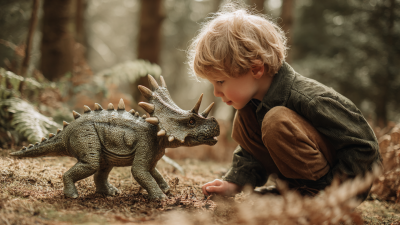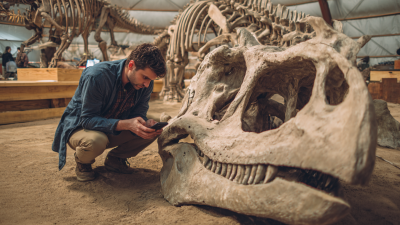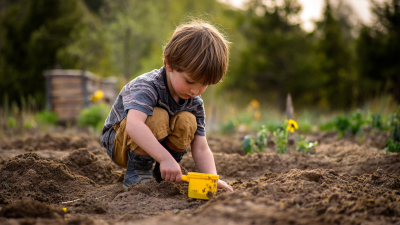7 Creative Tips for Maximizing Fun with Parent-child Educational Dig Toys
Table of Contents
- Choosing the Right Educational Dig Toys for Different Age Groups
- Setting Up an Engaging Digging Space for Optimal Parent-Child Interaction
- Incorporating Themes and Challenges to Enhance Play and Learning
- Creative Ways to Document and Share Your Digging Adventures
- Making Educational Digging a Multi-Sensory Experience
- Tips for Organizing Regular Digging Activities to Foster Routine
- FAQS
- Conclusion
- Related Posts
The rise of parent-child educational dig toys has transformed the landscape of children's learning and play, offering a dynamic avenue for bonding while fostering essential skills. According to a recent market research report by Research and Markets, the global educational toys market is projected to reach USD 130 billion by 2025, driven by the increasing demand for products that promote creativity and critical thinking. Jinhua City Dukoo Toys Co., Ltd., established in 2009, has played a pivotal role in this evolution, specializing in customizable archaeological products that engage young minds in hands-on exploration.

As we delve into the seven creative tips for maximizing fun with parent-child educational dig toys, we invite you to discover innovative ways to enhance your child’s learning experience while creating lasting memories together.
Choosing the Right Educational Dig Toys for Different Age Groups
When selecting educational dig toys, it’s crucial to consider the developmental stages of your child. For toddlers, look for soft, lightweight toys that promote sensory play, such as sand molds or water-digging shovels. These toys not only enhance fine motor skills but also encourage exploration and imaginative play. Materials that are safe and easy to clean are essential at this age, as children are prone to putting toys in their mouths.
As children grow, their interests and capabilities change. For preschoolers, consider introducing more complex digging sets that include tools like mini excavators or construction-themed playsets. These not only bolster their hand-eye coordination but also nurture early engineering skills. For school-aged children, digging toys that incorporate STEM concepts—like kits that allow them to dig for "fossils" or treasure—can spark curiosity about science and geology while providing a hands-on learning experience. Choosing age-appropriate toys ensures that playtime remains engaging, educational, and safe for every stage of growth.
7 Creative Tips for Maximizing Fun with Parent-child Educational Dig Toys - Choosing the Right Educational Dig Toys for Different Age Groups
| Age Group | Recommended Toy Types | Key Benefits | Creative Tips |
|---|---|---|---|
| 2-3 Years | Soft Digging Tools | Develops motor skills | Incorporate colorful sand |
| 4-5 Years | Mini Excavators | Encourages imaginative play | Set up mini construction sites |
| 6-7 Years | Digging Kits | Enhances problem-solving skills | Create treasure hunts |
| 8+ Years | Advanced Digging Sets | Promotes teamwork | Organize group challenges |
Setting Up an Engaging Digging Space for Optimal Parent-Child Interaction
Creating an engaging digging space for parent-child interactions can significantly enhance the educational benefits of archaeological dig toys. According to a recent industry report, 78% of parents believe that hands-on play is crucial for cognitive development, underscoring the importance of immersive experiences. By designing a dedicated digging area, families can foster a sense of adventure and curiosity, allowing children to explore the wonders of archaeology firsthand. This can be achieved by using sandboxes filled with varied materials that mimic excavation sites, making the experience both educational and enjoyable.
At Jinhua City Dukoo Toys Co., Ltd., our commitment to creating high-quality archaeological toys since 2009 reflects an understanding of these developmental needs. As our factory has expanded from 400 to 8000 square meters, we have been able to focus on customizing products that enhance the learning experience. Research highlights that children remember 90% of what they do, compared to only 10% of what they hear. Thus, when children are actively involved in digging and discovering, it not only builds their problem-solving skills but also deepens their appreciation for history and science. Encouraging parent-child collaboration in this engaging environment can lead to lasting memories and a shared passion for learning.
Incorporating Themes and Challenges to Enhance Play and Learning
Incorporating themes and challenges into parent-child play with educational dig toys can significantly enhance both fun and learning. Educational toys are not just tools for play; they provide invaluable opportunities for children to develop essential skills such as problem-solving, critical thinking, and creativity. According to a recent study by the American Academy of Pediatrics, children who engage in thematic play demonstrate improved cognitive skills and better emotional regulation. By integrating specific themes—like space exploration or ancient archaeology—parents can create immersive learning experiences that captivate children's interests and enhance their knowledge retention.
Moreover, the implementation of challenges within these play scenarios can further ignite children's motivation and engagement. For instance, setting up treasure hunts with educational clues fosters teamwork and communication between parents and children, turning learning into an adventure. Research from the Journal of Play indicates that interactive challenges can increase children's focus levels by up to 70%. Such educational approaches not only bolster financial literacy or legal awareness through themed activities—as seen in recent community events—but also lay a strong foundation for lifelong learning habits in a playful and engaging manner.

Creative Ways to Document and Share Your Digging Adventures
Documenting and sharing your parent-child digging adventures can turn a simple outdoor activity into a creative learning experience. According to recent studies, outdoor play is essential for child development, contributing to social skills, cognitive growth, and physical health. Engaging in activities like digging in the sand encourages children to explore their surroundings while helping them develop fine motor skills. Try using a smartphone to capture moments as your child digs deep, uncovering hidden treasures or even mini fossils, sparking curiosity about history and science.
To make the most of your experiences, consider these creative tips. First, keep a digging journal where both parent and child can document their findings with sketches and notes. This not only enhances the educational aspect but also fosters a bond as you both reflect on your adventures. Second, create a themed scrapbook that incorporates photographs, interesting facts about your finds, and even sand samples, making the process more interactive. Finally, share your adventures on social media platforms, creating a digital collage that connects with other families and highlights the importance of outdoor play in child development. By immersing yourselves in these activities, you’re cultivating a lifelong love for learning and exploration.

Making Educational Digging a Multi-Sensory Experience
Engaging children in educational digging play can create a rich multi-sensory experience that enhances learning and development. Research indicates that multi-sensory learning not only boosts cognitive skills but also improves retention rates by up to 75%. When children physically interact with materials—feeling the textures of sand, stone, or soil while they dig—they are likely to make deeper connections and foster critical thinking skills. This experiential learning approach encourages curiosity and exploration, essential components for childhood development that are recognized by educational experts globally.
To maximize the fun and educational value of digging activities, integrating various sensory elements can make a significant impact. For example, incorporating different colors of digging materials can appeal to visual learners while adding water play enhances tactile experiences. According to a study published by the American Academy of Pediatrics, children exposed to multi-sensory educational activities demonstrate improved language skills, helping them articulate their thoughts more effectively.
By combining sound, sight, and touch, parents can create a captivating environment that engages children’s imaginations and promotes cooperative play, making every digging session not just fun but also an impactful learning opportunity.
Tips for Organizing Regular Digging Activities to Foster Routine
Creating routine digging activities with parent-child educational dig toys can offer both fun and developmental benefits for children. Establishing a consistent schedule for these activities not only helps children anticipate and look forward to playtime but also supports their cognitive and social-emotional growth. Research has shown that routines can have positive outcomes in various developmental areas, making these activities more than just a pastime; they are vital for children's overall well-being.
To maximize enjoyment and engagement, consider the following tips:
- First, designate a specific day and time each week for your digging activities. This regularity not only fosters a sense of stability for children but also encourages them to explore different themes—be it dinosaurs, underwater exploration, or treasure hunts—keeping their interest piqued.
- Second, involve children in the planning process. Allow them to choose themes and contribute ideas, which can enhance their ownership of the activity and strengthen their decision-making skills.
- Finally, incorporate reflection time after each session. Discussing what was discovered can help sharpen cognitive skills and reinforce learning.
Creating a joyful environment centered around regular digging activities can significantly contribute to a child’s development while also nurturing the parent-child bond.
FAQS
: For toddlers, it's important to select soft, lightweight toys that promote sensory play, like sand molds or water-digging shovels, which enhance fine motor skills and encourage exploration.
Preschoolers benefit from more complex digging sets, including mini excavators or construction-themed playsets, which help develop hand-eye coordination and early engineering skills.
Digging toys that incorporate STEM concepts, such as kits for digging "fossils" or treasures, can spark curiosity about science and geology while providing a hands-on learning experience.
Multi-sensory learning can enhance cognitive skills and improve retention rates by up to 75%, as children engage physically with materials and make deeper connections through exploration.
To enhance sensory experiences, incorporate different colors of digging materials and include water play to appeal to visual and tactile learners.
Designate a specific day and time each week for digging activities, involve children in planning themes to maintain interest, and include reflection time after sessions to reinforce learning.
Establishing regular digging activities helps children anticipate playtime and supports their cognitive and social-emotional growth, making the activities integral to their overall well-being.
Multi-sensory educational activities, such as digging play, can improve children's language skills and help them articulate their thoughts more effectively.
You can explore various themes such as dinosaurs, underwater exploration, or treasure hunts to keep the activities interesting and stimulate your child's imagination.
Creating a joyful environment centered around regular digging activities can nurture the parent-child bond while contributing to the child’s development.
Conclusion
In the blog titled "7 Creative Tips for Maximizing Fun with Parent-child Educational Dig Toys," we explore innovative strategies to enhance the educational experience of digging activities for both parents and children. Key topics include selecting the right educational dig toys tailored to different age groups, creating an engaging and interactive digging space, and incorporating themes and challenges that foster both play and learning. By documenting your adventures and making the digging experience multi-sensory, you not only enrich the time spent together but also lay a strong foundation for learning.
Additionally, we discuss how to organize regular digging activities to establish a routine that cultivates curiosity and collaboration. With a focus on fostering meaningful parent-child interactions through these educational tools, Jinhua City Dukoo Toys Co., Ltd. is committed to providing high-quality archaeological toys that nurture learning and play for families around the globe.
Related Posts
-

How to Unlock the Secrets of Fossil Discovery Toy for Young Explorers
-

Creative Solutions for Enhancing Learning with Prehistoric Fossil Dig Toys
-

The Future of Interactive Dinosaur Bone Dig Experiences
-

10 Essential Tips for Creating the Perfect Outdoor Dig Pit for Kids
-

Ultimate Guide to Unleashing the Secrets of Your Crystal Mining Kit
-

How to Choose the Best Digging Toys for Your Child's Outdoor Adventures
Blog Tags:

